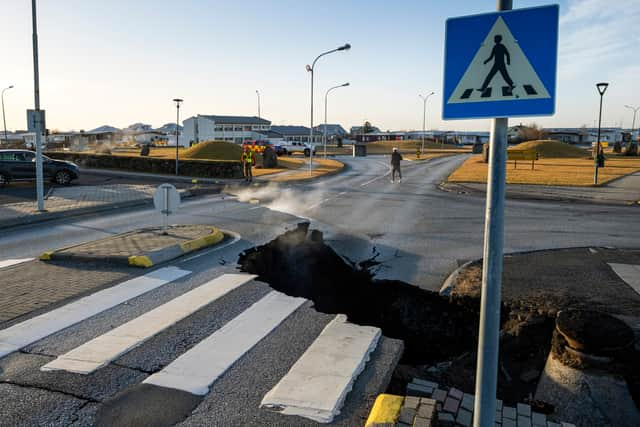Iceland: What is a volcano, tectonic plates, earthquakes and eruptions explained - as Grindavik fears grow
and live on Freeview channel 276
Residents of a fishing town in south-western Iceland have evacuated their homes in the wake of heightened concerns about a potential volcanic eruption.
The declaration of a state of emergency by civil defence authorities has prompted the evacuation of Grindavik, as recent seismic activity in the region migrated southward toward the town.
Advertisement
Hide AdAdvertisement
Hide AdMonitoring efforts revealed that a corridor of magma, or semi-molten rock, has extended beneath the community, leading to the decision by the police to initiate the evacuation.
Situated on the Reykjanes Peninsula, approximately 30 miles south-west of the capital, Reykjavik, Grindavik is home to a population of 3,400. The Iceland Meteorological Office underscored the uncertainty surrounding the situation, stating that, at this point, it is impossible to ascertain precisely whether and where magma might breach the surface.
In response to the escalating situation, authorities have elevated the aviation alert level to orange, indicating a heightened risk of a volcanic eruption.
But what exactly is a volcano? How are they formed, and why are they primarily located in certain locations around the globe? Here is everything you need to know about them.
Advertisement
Hide AdAdvertisement
Hide AdWhat are volcanoes?


Volcanoes are natural geological features that result from the dynamic processes of Earth's fiery core, manifesting in various shapes and sizes across the globe.
Volcanoes form through the movement of the tectonic plates that make up the Earth's rigid outer shell, which is divided into several large and small plates that constantly interact.
One primary process that contributes to volcano formation is that of subduction, where one tectonic plate is forced beneath another. As the subducting plate descends into the Earth's mantle, it experiences intense heat and pressure, causing it to melt.
This molten rock, or magma, is less dense than the surrounding rock, and it rises through fractures and weaknesses in the crust, eventually reaching the surface and erupting as a volcano.
Advertisement
Hide AdAdvertisement
Hide AdWhy are volcanoes usually found in certain regions?
Volcanic activity is closely tied to plate boundaries, where plates converge, diverge or slide past each other. Volcanoes are primarily concentrated along tectonic plate boundaries, such as the Pacific "Ring of Fire", a horseshoe-shaped zone encircling the Pacific Ocean, which is particularly renowned for its high volcanic activity.
"Subduction zones", where oceanic plates plunge beneath continental plates or other oceanic plates, are also common sites for explosive volcanic activity, and "divergent boundaries", where plates move apart, often give rise to volcanic activity as magma ascends to fill the gaps.
But while these plate boundaries are marked by frequent earthquakes and numerous active volcanoes, the distribution of volcanoes is not solely confined to them, and "hotspots" also contribute to their formation. Hotspots are areas of exceptionally high heat within the Earth's mantle that generate magma. Despite their fixed location, tectonic plates drifting over these hotspots lead to the creation of volcanic chains. The Hawaiian Islands, for example, are a result of the Pacific Plate drifting over a hotspot, producing a series of volcanoes in its wake.
How do volcanoes erupt?
Volcanic eruptions begin with the formation of magma, a molten mixture of rock, minerals and dissolved gases, a process typically driven by the heat generated from the Earth's core and mantle. Once formed, the magma begins to rise through the Earth's crust, facilitated by the buoyancy of the magma, as it is less dense than the surrounding rock. The ascent is influenced by factors such as the magma's composition, temperature and the presence of gases.
Advertisement
Hide AdAdvertisement
Hide AdAs magma rises, it can encounter resistance from the overlying rocks. This pressure can lead to the fracturing of the Earth's crust, creating pathways for the magma to reach the surface. These fractures or conduits may extend from deep within the Earth to the surface.
As magma rises towards the surface, the decreasing pressure allows dissolved gases (such as water vapour, carbon dioxide and sulphur dioxide) to expand rapidly. The expansion of gases within the magma contributes to the build-up of pressure, further aiding the ascent of magma. When the pressure becomes too great, the magma breaches the surface, resulting in a volcanic eruption.
What happens when a volcano erupts?
Volcanic eruptions vary in intensity and style. Some eruptions are explosive, characterised by the release of ash, lava and gases, while others are effusive, featuring the steady flow of lava.
During an eruption, various materials are expelled, including lava (molten rock), ash (fine particles of fragmented volcanic rock), pyroclastic flows (rapidly moving mixtures of hot gas and volcanic rock fragments), and volcanic gases. The impact of volcanic activity extends beyond geological phenomena, influencing climate, ecosystems and human activities. Volcanic ash can travel vast distances, affecting weather patterns and air travel.
Advertisement
Hide AdAdvertisement
Hide AdBut volcanoes can also have a lot of positive effects on their ecological surroundings, and the deposition of volcanic material enriches the soil, fostering unique ecosystems around volcanic landscapes.
Comment Guidelines
National World encourages reader discussion on our stories. User feedback, insights and back-and-forth exchanges add a rich layer of context to reporting. Please review our Community Guidelines before commenting.
